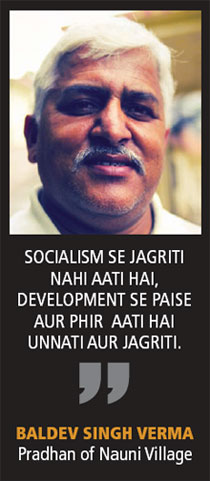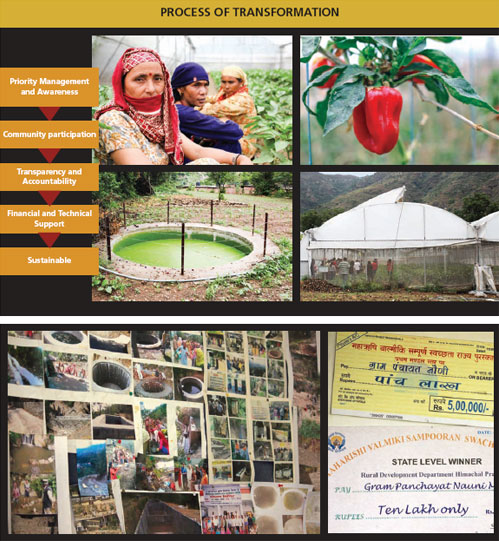THE NAUNI STORY
By: SHUBHAM BOHRA & SANJALA
HARI
Baldev Singh Verma was elected pradhan, unopposed, of Nauni gram panchayat in 2006 when this
'model village' was carved out from the Ojghat panchayat.
In a village of 300 households,
150 have toilets in their homes.

And they are all soak pit and
toilets with bio remediation
methods. 90 per cent of the
households harvest their own
rainwater.
From a village where open
defecation was the norm, and water
borne diseases were rampant,
Verma led this village's transformation into one of India’s finest,
self-sustaining model village. The
transformation started with
discussion, debate and final
acceptance by the Gram Sabha, or
village council. To use government
schemes for transformation ensured
speedy, effective and long-term
solutions to the issues faced by all.
Community Led Total Sanitation
(CLTS)
The transformation started when the
Gram Pradhan was trained in a
program called CLTS by Dr. Kamal
Kar. Community Led Total Sanitation is an innovative approach that
involves community participation to
eliminate open defecation. Making
Nauni an open defecation free (ODF)
zone was the top priority, one that
was shared by the state, which had
schemes to support community led
efforts to rid villages of this
debilitating 'habit'. Through the
Gram Panchayat, the villagers learnt
about the problems caused by open
defecation and as a community,
agreed to be a part of the program.
It was important to include the
socially excluded. For instance,
Budhram and Devi Lal, members of
the Scheduled Caste community,
innovatively used their ginger pits to
make a bio-friendly toilet, which was
essentially a pit where human
excreta was decomposed by bacteria
and converted into bio gas and
water. Nauni soon was an open
defecation free village.
Enhancing Livelihoods
In Nauni, high value vegetables like
bell peppers were always grown by
the villagers. But the yield was low.
The villagers were afraid of the
concept and cost of polyhouses.
Through training, the villagers were
made aware of the merits of a
polyhouse and how, with the joint
financial support of the community,
they could effectively purchase one.
Verma explains, "The entire village
agreed to adopt a model where
government intervention will be at a
minimum and all the resources are
ultimately owned by the people
collectively". Three hundred families
contributed one lakh rupees each to
buy polyhouses that increased the
yield of the vegetables. With the
help of the Pradhan, the villagers
were informed of their cost-benefit
ratio. The soil was also tested to
know the nutrient content so that
the right amount of manure could
be added.
Women participation was
encouraged in all spheres. They were
empowered to share their views,
feedback and even encouraged to
take initiatives. Value addition in the
dairy sector was women centric.
'Teach the people', a supplementary
to CLTS was implemented to
educate the community (especially
among the vulnerable, the elderly
and children) about various
problems faced and their solutions.
This initiative has been successful in
Nauni.
Connecting the Dots
For a layman 'government schemes'
and 'banks' are intimidating. But the
villagers in Nauni were educated on
the various schemes available, and
its effects. Verma explains, "A
competitive spirit can act as the
biggest driver of action, but for it to
be really effective, the process has to
be transparent for all". Therefore the
villagers were more confident when
a particular scheme was implemented and were in full support of
the changes that followed.
The Pradhan, with the help of the
gram sabha, helped in construction
of roads within and beyond the
village. The terrain being hilly, roads within the village helped in the easy
commute of the villagers as well as
easy transport of the produce. The
highway built outside the village
made connectivity easier to the
main city. The government scheme
used for this was the Pradhan
Mantri Gram Sadak Yojana.

With the help of the State and
central government schemes,
renewable energy sources were
installed. Biogas plants and solar
lanterns are set up across the
village. Rain water harvesting is
practiced consciously and substantially. Many water storage
structures are constructed all over
the village and there are many pipes
connecting these to the houses.
The biggest question one can
ask is 'what is the future of this
model village?' The Pradhan and
his team seem to be answering this
consequential question by their
work and not words.
When you understand the way
this village is evolving and growing,
one is reminded of Gandhiji's dream
of Gram Swaraj or ex-president
A.P.J Abdul Kalam's PURA (Providing Urban Amenities to Rural
Areas) initiative and how finally it is
being practiced.
| |
